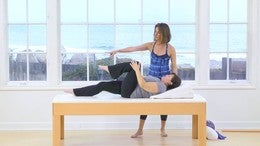Premium workshop
You can view a 2 minute preview. For details, scroll down below the video.
Workshop #2337
Pilates for People of Size
Description
Objectives
- Learn about the challenges of working with a larger body
- Learn how to give a basic assessment and how to develop a program that will keep them safe
- See how modifications and props can be used on the Mat and Apparatus so your client can experience the joy of movement
About This Video
Comments
You need to be a subscriber to post a comment.
Please Log In or Create an Account to start your free trial.





















